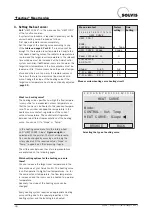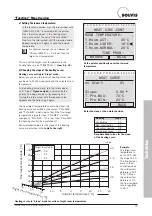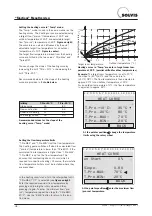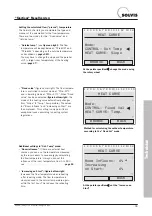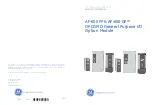
P32-EN – Subject to technical changes 04.11
50
Additional Information for Installers
10.2 Frequently asked questions about SolvisControl
10.2.1 How are the solar pumps controlled?
When does the primary solar circuit pump switch on?
Whenever the collector temperature (“T.Collector”, input 8)
is higher than the temperature in the lower part of the
storage tank (“T.Ref.Sto”, input 3) by SolvisControl set
switch-on difference (“DIFF.ON”). This only happens in the
“AUTO” operating function. “DIFF.ON” should be the same
as the switch-off difference “DIFF.OFF” plus a hysteresis
of approx. 5 K.
Explanation:
You should enter a hysteresis so that the pump does not
switch off immediately when the value drops below 15 K.
Factory setting on the SolvisControl: “DIFF.OFF” = 10 K
and “DIFF.ON” = 15 K.
Switch-on condition:
Solar circuit ON:
“T.Collector” – “T.Ref.Sto”
≥
“DIFF.ON”
When does the primary solar circuit pump switch off?
Whenever the “Collector temperature – Reference tempera-
ture” difference exceeds the set value of “DIFF.OFF” (factory
setting 10 K) on the controller.
Switch-off condition:
Solar circuit OFF: “T.Collector” – “T.Ref.Sto” < “DIFF.OFF”
We recommend that “DIFF.OFF” = 10 K and
for “DIFF.ON” = “DIFF.OFF” + 5 K.
How does the speed control work?
The primary solar pump has a speed control. The flow is
set in such a way as to make water in the tank reach the
hot water standby temperature as quickly as possible
(12 K above target hot water temperature). Higher tempera-
tures are not advisable, as they would make the collector
less effective. The pump runs at its highest speed for
90 seconds, then it drops down to the target temperature
on the collector sensor (S8). This is the quickest way to
raise the collector operating temperature. The collectors
reach an optimal minimum temperature that can be held
constant by raising or lowering the flow when temperatures
rise or fall. Higher temperatures can also occur when the
maximum speed has been reached. Do not reduce the
flow in the solar circuit; the flow meter must be completely
open.
This controller guarantees that the collectors warm up
quickly when the sun begins to shine. This, together with
the stratified charger, brings the tank to standby more
quickly. Compared with conventional systems, the burner
needs to provide less auxiliary heat.
When does the safety function deploy?
The maximum tank temperatures “T.Lim.MAX” (upper) and
“T.Ref.MAX” (lower) are factory preset to 95°C and 90°C.
Specifying a maximum tank temperature allows for a two-
fold safety function, meaning the solar pump switches off
when:
a) The temperature at the “T.WW.Buffer” (input 1) sensor
is greater than the maximum temperature “T.Lim.MAX”
or
b) The temperature at the “T.Ref.Sto” (input 3) sensor is
greater than “T.Ref.MAX”
A hysteresis (factory setting 3 K) is taken into account so
that the solar pump does not switch back on immediately
if “T.WW.Buffer” drops below its set value. The solar pump
switches back on when:
a) “T.WW.Buffer” < “T.Lim.MAX” – “Hysteresis”
or
b) “T.Ref.Sto” < “T.Ref.MAX” – “Hysteresis”.
How is the secondary solar circuit pump controlled ?
The pump in the secondary solar circuit is switched on
when the pump of the primary circuit switches on and the
flow (pre-run) temperature of the primary circuit T
VL1
(S7)
is higher than the temperature in the lower part of the
storage tank “T.Ref.Sto” plus a switch-on temperature
difference of 8 K. It is turned off when the primary solar
circuit pump switches off or T
VL1
< “T.Ref.Sto” + 5 K.
The speed is controlled so that the flow (pre-run) tempera-
ture of the secondary solar circuit T
VL2
(
figure below
)
is 7 K higher than the hot water target temperature
(T.WW.NOM). A frost protection function ensures that the
heat exchanger does not freeze in winter.
T
VL1
T
VL2
Primary
circuit
(Collector)
Secondary
circuit
(Storage)
Principle of the solar heat transfer station
Plate heat
exchanger

